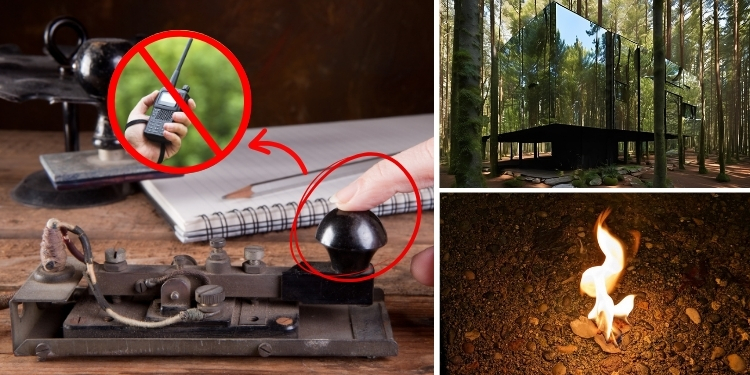6 Ingenious Ways to Communicate Post‑SHTF (It’s Not HAM Radio)

If you are an experienced prepper, you’ve likely discovered plenty of ways to communicate. When the grid goes down, cell towers go silent, and the internet vanishes, staying in touch becomes a survival skill. But let’s be honest, HAM radio isn’t your only option. There are plenty of clever ways to communicate that can help you stay connected when the going gets tough.
We’ve already talked about how to communicate when the grid is down, but we’ve come up with a few more handy ideas. This time, we’re bringing a bit of old-school ingenuity.
Signal Mirrors
 If you position the mirrors correctly, signal mirrors can send your messages for miles. Not only that, but they are lightweight and battery-free, which means you can use them without needing extra supplies.
If you position the mirrors correctly, signal mirrors can send your messages for miles. Not only that, but they are lightweight and battery-free, which means you can use them without needing extra supplies.
You don’t need a fancy military mirror in your prepping kit. In fact, any reflective surface, like a small compact mirror, a piece of polished metal, or even the back of a smartphone, can work in a pinch.
To send a message, tilt the mirror so the sun reflects toward your intended target. Then, use a series of short and long, or pre-arranged patterns to convey information.
A helper or spotter can identify your flashes against the natural background light. With a bit of practice, one person can send signals across hills, valleys, or any open terrain.
The best part? No one else hears it, and you’re not relying on electricity, cell towers, or radios. Once you’ve tried it, you’ll understand why preppers swear by it as a quiet, ingenious way to get a message through.
Fire and Smoke Signals
As you know, smoke and fire are among the oldest ways humans have communicated and sent messages. For instance, signal fires are great to relay warnings or coordinate movements.
Different patterns of smoke puffs or fire flashes can communicate specific messages, such as three quick puffs for “danger,” a long, continuous column for “all clear,” or intermittent flashes to indicate a particular location.
Even simple methods worked surprisingly well if everyone agreed on the code ahead of time. The key is line of sight: hills, ridges, or watchtowers were often used to extend the range of vision.
In a modern prepper scenario, controlled signal fires can still be effective, but you’ll want to plan carefully to avoid attracting unwanted attention and always have a safe way to put the fire out.
If you want to learn how to communicate this way, the VIDEO below will show you the safest setups, timing, and techniques for long-distance signaling in the wild.

Whistles and Sound Signals
Sometimes sound travels farther than you think. Whistles, horns, or even banging metal can communicate across short to medium distances. Like with any other no-tech communication method, the key is to establish a pattern that everyone knows.
For example, three short blasts could mean “come here,” while one long blast could mean “danger.” Once everyone is trained, it works reliably under stress.
Morse Code
Morse code has been around since the 1830s, and there’s a reason it’s still in use. Long story short, it’s simple, effective, and requires minimal equipment. A flashlight, a mirror, or even tapping on a pipe can send a coded message over surprisingly long distances.
The trick is to have pre-arranged codes so your team can understand them quickly. SOS is obvious, but you might also use three short flashes for “come here” or a long one for “danger”.
Once you know the Morse code basics, you can signal across fields or down a road without anyone else noticing. It’s low-tech, reliable, and perfect for quiet communication.
In his book Bug-in Guide, Navy SEAL Joel Lambert recommends pairing Morse signals with pre-agreed messages. Doing this helps avoid confusion when stress is high, which is exactly when clear communication matters most.
I also recommend keeping this book on hand, as it’s full of practical advice on how to communicate effectively after a grid-down or post-SHTF situation.
Click play and find out more:

Reflective or Colored Tape Codes
A note left in a pre-agreed location is simple, secure, and reliable, but it’s not very subtle. For a more discreet approach, use colored tape to communicate important messages.
Instead of paper notes, use reflective tape, colored cloth, or glow-in-the-dark markers to create simple, pre-arranged signals in key locations. You can leave these codes on trees, fence posts, or buildings to silently communicate messages like “safe,” “danger,” or “help needed.”
The beauty of this method is that it’s instant and reusable. Even without electricity, everyone in your group who knows the code can quickly interpret it. It’s discreet, can work at night with reflective/glow materials, and can be combined with mirrors or lights for added clarity.
Flags and Cloth Signals
Historically, armies and ships used flag codes to coordinate movements or relay orders. We can all learn from history. A simple colored cloth tied to a pole or waved in a specific rhythm can work surprisingly well. The key when using this method is consistency – each movement or color represents a specific signal, similar to Morse code.
The key when using this method is consistency – each movement or color represents a specific signal, similar to Morse code.
You can also combine this method with others, like signal mirrors or light flashes, to ensure your message gets through even if one method fails.
The advantages are clear: it’s inexpensive, reusable, and doesn’t rely on electricity or cell towers.
How effective are these methods?
The tools we’ve explored may be simple and handy in a pinch, but they can pack a serious punch when it comes to staying in touch. So, let’s be honest – even if you’ve practiced signaling with mirrors, waving flags, or tapping out Morse code, nothing beats having a working radio when the world goes quiet.
But, when it comes to protecting your gear, there’s one threat that can silence it all in a split second: an EMP. As most of you know, this is a powerful electromagnetic pulse can travel hundreds of miles and burn out every circuit it touches – radios, solar generators, GPS units, even that old backup phone you keep in your bug-out bag.
What many people don’t realize is that there’s an easy way to protect their gear. The EMP protection fabric, often called EMP cloth, is woven with conductive metals like copper and nickel. When used properly, it redirects the surge around your devices instead of through them – the same principle used in military-grade Faraday cages.
👉 Secure your communication gear with a military-approved EMP Cloth!
You may also like:

What Is Morse Code?
The Crisis That Ends America (VIDEO)
6 Post-SHTF Communication Myths
Can 5G Penetrate a Faraday Cage?
10 Household Items You Can Use to Communicate Post-EMP
Read the full article here









